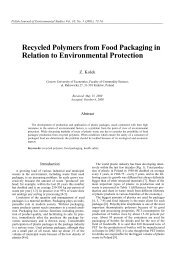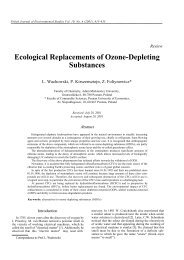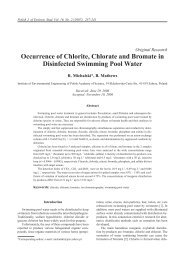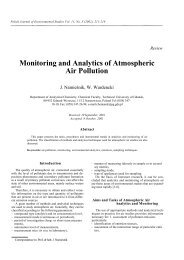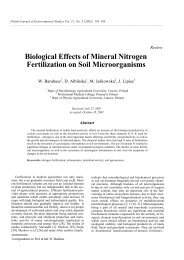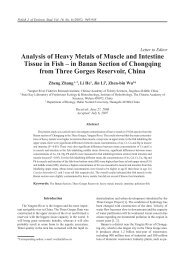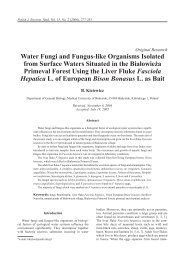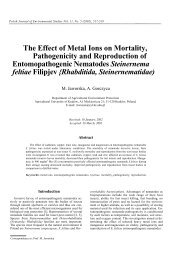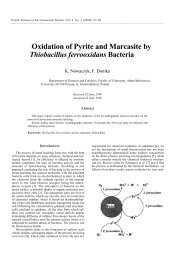Alfalfa (Medicago sativa L.) - Polish Journal of Environmental Studies
Alfalfa (Medicago sativa L.) - Polish Journal of Environmental Studies
Alfalfa (Medicago sativa L.) - Polish Journal of Environmental Studies
Create successful ePaper yourself
Turn your PDF publications into a flip-book with our unique Google optimized e-Paper software.
<strong>Polish</strong> J. <strong>of</strong> Environ. Stud. Vol. 19, No. 5 (2010), 913-919<br />
Original Research<br />
<strong>Alfalfa</strong> (<strong>Medicago</strong> <strong>sativa</strong> L.) Apigenin Glycosides<br />
and Their Effect on the Pea Aphid<br />
(Acyrthosiphon pisum)<br />
Sylwia Goławska 1 *, Iwona Łukasik 1 , Artur Goławski 2 ,<br />
Ireneusz Kapusta 3 , Bogdan Janda 3<br />
1<br />
Department <strong>of</strong> Biochemistry and Molecular Biology, University <strong>of</strong> Podlasie, Prusa 12, 08-110 Siedlce, Poland<br />
2<br />
Department <strong>of</strong> Zoology, University <strong>of</strong> Podlasie, Prusa 12, 08-110 Siedlce, Poland<br />
3<br />
Department <strong>of</strong> Biochemistry, Institute <strong>of</strong> Soil Science and Plant Cultivation,<br />
Czartoryskich 8, 24-100 Puławy, Poland<br />
Received: 6 October 2009<br />
Accepted: 22 April 2010<br />
Abstract<br />
Flavonoids are a group <strong>of</strong> secondary metabolites found in most families. They are known to have important<br />
physiological functions in plants by protecting them against biotic stresses. Liquid chromatography<br />
(HPLC) was used to determine the flavonoid pr<strong>of</strong>iles, especially apigenin glycosides, their total concentration,<br />
as well as changes in the amount <strong>of</strong> six flavones found in the aerial parts <strong>of</strong> alfalfa (<strong>Medicago</strong> <strong>sativa</strong> L.)<br />
(Fabaceae) Radius cv. for three vegetative stages, uninfested and infested by the pea aphid (Acyrthosiphon<br />
pisum Harris) (Homoptera: Aphididae). It has been shown that both control and infested green aerial parts <strong>of</strong><br />
alfalfa plants had similar flavonoid pr<strong>of</strong>iles. The dominant flavonoid <strong>of</strong> alfalfa was compound 7-O-[2-O-feruloyl-β-D-glucuronopyranosyl(1→2)-O-β-D-glucuronopyranosyl]-4’-O-β-D-glucuronopyranosideapigenin.<br />
Compound 4’-O-β-D-glucuronopyranosideapigenin was present in the smallest amounts. The total concentration<br />
<strong>of</strong> flavones was rather high and ranged from 10.32 to 12.28 mg/g d.m., but there were no significant differences<br />
between uninfested and infested alfalfa plants. There was a negative correlation between the concentration<br />
<strong>of</strong> total apigenin glycosides in the alfalfa plants and pea aphid abundance and phloem sap ingestion.<br />
This finding may indicate the importance <strong>of</strong> apigenin glycoside forms as nutritional compounds.<br />
Keywords: <strong>Medicago</strong> <strong>sativa</strong>, flavonoids, apigenin glycosides, herbivore, Acyrthosiphon pisum<br />
Introduction<br />
<strong>Alfalfa</strong> (<strong>Medicago</strong> <strong>sativa</strong> L. (Fabaceae)) is an important<br />
crop used as feed for livestock [1]. One <strong>of</strong> the most serious<br />
pests <strong>of</strong> alfalfa is the pea aphid (Acyrthosiphon pisum<br />
Harris), and previous research demonstrated a reduction in<br />
alfalfa yields as a function <strong>of</strong> the pea aphid population level<br />
[2]. Moreover, the pea aphid is an important vector <strong>of</strong><br />
legume viral diseases [3].<br />
*e-mail: sylwia@ap.siedlce.pl<br />
In addition to the nutritional components (proteins and<br />
carbohydrates) that are important in the use <strong>of</strong> alfalfa and<br />
other plants as animal feed or food supplements, the plants<br />
produce a variety <strong>of</strong> secondary metabolites. Many <strong>of</strong> these<br />
secondary metabolites help to protect the plant against herbivores<br />
[4-6], and it has been shown that plant metabolites<br />
can also influence the choice <strong>of</strong> food sources by insect herbivores<br />
[7-9].<br />
<strong>Alfalfa</strong> contains numerous secondary metabolites [10-<br />
13], but they are not yet fully characterized. The most studied<br />
secondary metabolite groups in alfalfa are the carotenoids
914 Goławska S., et al.<br />
and saponins [14-16]. Another important group <strong>of</strong> secondary<br />
metabolites in alfalfa are phenolic compounds [17]. The toxicity<br />
<strong>of</strong> phenolic compounds to herbivores and plant<br />
pathogens has been the focus <strong>of</strong> substantial research [18-21].<br />
Phenolic compounds in plants include the flavonoids.<br />
Flavonoids are usually found in plants as glycosides, i.e.<br />
provided with sugar substituents such as galactose, rhamnose<br />
or glucose, or glycoside malonates [22], and they are<br />
found in an almost bewildering diversity <strong>of</strong> forms [23].<br />
Recent work on alfalfa flavonoids revealed that they consist<br />
<strong>of</strong> among other things, apigenin glycosides. Apigenin glycosides<br />
have been previously separated from alfalfa aerial<br />
parts and their structures were confirmed by UV, MS, and<br />
NMR spectroscopy [12, 13]. These compounds possessed<br />
glucuronic acid in the sugar chain. Some <strong>of</strong> them were acylated<br />
with ferulic or coumaric acids (Fig. 1). Apigenin glycosides<br />
play a very important role in plant development and<br />
physiology, especially during their interactions with other<br />
living organisms. Flavonoid glycosides and free aglycones<br />
are involved in pathogenic and symbiotic interactions with<br />
microorganisms [24, 25]. They also affect plant-plant and<br />
plant-insect interactions [26]. Flavonoids are also thought<br />
to affect insect behaviour and performance [27-29], and<br />
many <strong>of</strong> them are being tested for their ability to repel or<br />
deter insects [27, 30-33]. Flavonoids can also modulate the<br />
feeding behaviour <strong>of</strong> insects [34-36]. However, the effect <strong>of</strong><br />
increasing the levels <strong>of</strong> specific flavonoids in plants on<br />
insects is unknown.<br />
Although a number <strong>of</strong> flavonoids from different parts <strong>of</strong><br />
the alfalfa plant have been identified [12, 13, 37], our<br />
understanding about the specific flavonoids present in alfalfa,<br />
their concentrations and effects on insects remains poor.<br />
The present study, therefore, analyzed the total flavonoid<br />
content and apigenin glycosides from the green aerial parts<br />
<strong>of</strong> alfalfa and investigated the influence <strong>of</strong> these compounds<br />
on the pea aphid.<br />
Materials and Methods<br />
Plant Material<br />
<strong>Alfalfa</strong> cv. Radius (<strong>Medicago</strong> <strong>sativa</strong> L. ssp. falcata x<br />
ssp. <strong>sativa</strong>), which has a high saponin content (65% <strong>of</strong> dry<br />
matter), was used in this study. Seed samples were obtained<br />
from the Plant Breeding and Acclimatization Institute<br />
(IHAR) in Radzików/Błonie (near Warsaw, Poland). Seeds<br />
were germinated in an environmental chamber at 21±1°C,<br />
with 16 h daylight and 8 h <strong>of</strong> darkness, and 70% relative<br />
humidity. Plants were grown in 7×7×9 cm plastic pots (one<br />
plant per pot) filled with fine garden soil, commonly used<br />
for greenhouse experiments. The plants were regularly<br />
watered, and no extra fertilizer was added. The aerial parts<br />
<strong>of</strong> plants (in three vegetative stages: 6-, 9-, 12-month-old)<br />
that were uninfested or infested by Acyrthosiphon pisum<br />
were used in the experiments.<br />
Aphids<br />
The pea aphids came from a stock culture kept at the<br />
University <strong>of</strong> Podlasie in Siedlce, Poland. The aphids were<br />
collected from a laboratory culture reared on broad bean<br />
seedlings [Vicia faba L. var. Start (Fabaceae)] in an environmental<br />
chamber at 21±1°C, with 16 h daylight and 8 h<br />
<strong>of</strong> darkness, and 70% relative humidity. Before the experiments,<br />
female A. pisum were maintained on alfalfa cv.<br />
Radius for one full generation. The adult apterous females<br />
were then used in the experiments [38].<br />
Comp. R 1 R 2 R 3 R 4<br />
1 -H -OGluA -H -OH<br />
2 -H -OGluA -H -OGluA(2→1)GluA-2-O-Feruloyl<br />
3 -H -OGluA(2→1)GluA-2-O-Feruloyl -H -OGluA<br />
4 -H -OGluA(2→1)GluA-2-O-p-Coumaroyl -H -OGluA<br />
5 -H -OH -H -OGluA<br />
6 -H -OGluA(2→1)GluA-2-O-Feruloyl -H -OH<br />
Fig. 1. Chemical formula <strong>of</strong> analyzed alfalfa flavones.
<strong>Alfalfa</strong> (<strong>Medicago</strong> <strong>sativa</strong> L.) Apigenin Glycosides... 915<br />
Entomological Observations<br />
The entomological observations were carried out using<br />
an environmental chamber at 21±1ºC, 16 h daylight and 8 h<br />
<strong>of</strong> darkness, and 70% relative humidity. Plexiglass cages<br />
10×10×30 cm with a cheesecloth cover were used. The<br />
adult apterous females were caged (one female per cage,<br />
one cage per plant) on the abaxial side <strong>of</strong> the youngest, fully<br />
expanded leaves <strong>of</strong> the alfalfa, and allowed to deposit<br />
nymphs. After 24 h, all but one nymph was removed from<br />
each plant. Each plant age group (6-, 9-, and 12-monthsold)<br />
was represented by 10 independent replicate plants.<br />
Aphids on each plant were counted after 15 days.<br />
Electrical Penetration Graphs<br />
Feeding behaviour <strong>of</strong> the pea aphid on the Radius cv.<br />
was monitored using the Electrical Penetration Graphs<br />
(EPG) technique according to Tjallingii [39, 40]. The<br />
experiments were run for 8 h for 10 aphids, on 10 different<br />
plants placed in a Faraday cage. Apterous adult aphids were<br />
connected to a DC EPG amplifier (type Giga 4) by 2 cm<br />
gold wire, 20 μm in diameter, and approximately 2-3 cm<br />
long, and attached to the aphid with silver conductive paint<br />
(Demetron, L2027, Darmstadt, Germany). Another electrode<br />
was introduced into the soil. The studied insects were<br />
starved in a Petri dish for two hours before the recordings<br />
and then were placed on the abaxial surface <strong>of</strong> the<br />
youngest, fully expanded leaves <strong>of</strong> the plants. Aphid feeding<br />
activity was recorded using the data acquisition option<br />
on a PC and analyzed using STYLET 2.2 s<strong>of</strong>tware<br />
(Agricultural University, Wageningen, The Netherlands).<br />
The duration and number <strong>of</strong> the following behavioural<br />
aphid activities were determined: non-probing (Np pattern;<br />
aphids did not start probing), probing (intercellular stylet<br />
penetration activities; path C pattern – pathway; penetration<br />
<strong>of</strong> peripheral tissues – epidermis and mesophyll), sieve element<br />
penetration (E1 pattern), ingestion <strong>of</strong> phloem sap (E2<br />
pattern – aphid feeding), and xylem sap ingestion (G pattern).<br />
High-Performance Liquid Chromatography<br />
<strong>of</strong> Flavonoids<br />
Aerial parts <strong>of</strong> the 6-, 9-, and 12-month-old plants that<br />
were noninfested or infested by A. pisum were harvested,<br />
freeze-dried, ground, and kept in a desiccator in darkness<br />
until analyzed. Flavonoid analyses, including total<br />
flavonoid content and apigenin glycosides, followed<br />
Oleszek and Stochmal [41]. In short, each extract was<br />
obtained using the ASE 200 Accelerated Solvent Extractor<br />
(Dionex Corporation, Sunnyvale, USA) for 20 minutes<br />
with 70% methanol. The extracts were concentrated at 40ºC<br />
on a rotary evaporator until the methanol was removed and<br />
then loaded on C 18 cartridges (Waters, Poland) preconditioned<br />
with water. The flavonoids were then successively<br />
washed from the cartridges with water and 40% methanol.<br />
Methanolic fractions were evaporated on a rotary evaporator<br />
at 40ºC until dry, and the residue was redissolved in 1<br />
ml <strong>of</strong> 40% MeOH. Extracts were analyzed using high-performance<br />
liquid chromatography (HPLC) according to<br />
Oleszek and Stochmal [41]. Flavonoids were separated<br />
using a Waters HPLC system, consisting <strong>of</strong> a model 616<br />
pump and 99 G PAD detector (Waters Corporation,<br />
Milford, USA). The Millenium Chromatography Manager<br />
s<strong>of</strong>tware (Waters Corporation) was used to monitor chromatographic<br />
parameters and to process the data. The alfalfa<br />
samples were applied to a Eurospher PD 82 column and<br />
eluted at 1 ml min -1 with a linear gradient <strong>of</strong> 1% phosphoric<br />
acid in water: 40% acetonitrile in 1% H 3 PO 4 (65:35%),<br />
increasing to 0:100% over 60 min. Chromatograms were<br />
registered and integrated at 350 nm. Standards <strong>of</strong> apigenin<br />
and apigenin glycoside, purchased from the Biochemical<br />
Laboratory Institute <strong>of</strong> Soil Science and Plant Cultivation<br />
(Puławy, Poland), were used for calibration curve preparation.<br />
The total flavonoid concentration was calculated from<br />
the total integration area (350 nm) using the calibration<br />
curve <strong>of</strong> apigenin glycoside.<br />
Statistical Analysis<br />
The differences in foliar chemistry between uninfested<br />
(control) and infested alfalfa plants were analyzed with<br />
Student’s t test. The differences in levels <strong>of</strong> the apigenin<br />
glycosides in the studied alfalfa plants were subjected to<br />
one-way ANOVA followed by the post-hoc Duncan test.<br />
Influence <strong>of</strong> the apigenin glycosides on pea aphid abundance<br />
and feeding activities were analyzed using Spearman<br />
rank correlation. The Statistica program for Windows v. 6.0<br />
[42] was used for all statistical analyses.<br />
Results<br />
Variation in Flavonoid Pr<strong>of</strong>iles and Content<br />
among the Studied <strong>Alfalfa</strong> Plants<br />
Pea aphid uninfested and infested 6-, 9-, and 12-monthold<br />
alfalfa plants had similar flavonoid pr<strong>of</strong>iles. Apigenin<br />
glycosides were identified on the basis <strong>of</strong> the absorption<br />
spectra <strong>of</strong> the chromatograms. Previous HPLC-MS studies<br />
have been conducted with these compounds. Two compounds<br />
(1 and 5) were non-acylated and the rest were acylated.<br />
Compounds 2, 3 and 6 were acylated with ferulic<br />
acid, compound 4 with coumaric acid. Flavones, including:<br />
(1) 4’-O-β-D-glucuronopyranosideapigenin;<br />
(2) 7-O-[2-O-feruloyl-β-D-glucuronopyranosyl(1→2)-Oβ-D-glucuronopyranosyl]-4’-O-β-D-glucuronopyranosideapigenin;<br />
(3) 7-O-β-D-glucuronopyranosyl-4’-O-[2’-O-feruloyl-Oβ-D-glucuronopyranosyl(1→2)-O-β-D-glucuronopyranoside]apigenin;<br />
(4) 7-O-β-D-glucuronopyranosyl-4’-O-[2’-O-p-coumaroyl-<br />
O-β-D-glucuronopyranosyl(1→2)-O-β-D-glucuronopyranoside]apigenin;<br />
(5) 7-O-β-D- glucuronopyranosideapigenin; and
916 Goławska S., et al.<br />
Table 1. Foliar chemistry (mg/g dry matter ±SD)(average for Radius cv. in three studied stages).<br />
Substance category<br />
<strong>Alfalfa</strong> plants<br />
Statistics<br />
Unifested Infested t P-value<br />
Total flavonoids 10.32±1.72 12.28±0.58 1.868 0.135<br />
Total apigenin glycosides 3.55±0.52 3.99±0.10 1.435 0.224<br />
Apigenin nonacylated 0.77±0.05 0.85±0.06 1.408 0.232<br />
Apigenin acylated 2,78±0.48 3.14±0.14 1.263 0.275<br />
Table 2. The concentration (mg/g dry matter ±SD) <strong>of</strong> individual apigenin glycosides (average for Radius cv. in three studied stages).<br />
Apigenin<br />
glycosides*<br />
<strong>Alfalfa</strong> plants<br />
Statistics<br />
Unifested Infested t P-value<br />
(1) 0.131±0.077 0.190±0.030 1.235 0.284<br />
(2) 1.519±0.319 1.699±0.168 0.865 0.435<br />
(3) 0.444±0.054 0.409±0.073 0.666 0.541<br />
(4) 0.189±0.046 0.242±0.039 1.546 0.197<br />
(5) 0.640±0.028 0.655±0.080 0.293 0.784<br />
(6) 0.624±0.089 0.791±0.131 1.832 0.141<br />
*(1) 4’-O-β-D-glucuronopyranosideapigenin;<br />
(2) 7-O-[2-O-feruloyl-β-D-glucuronopyranosyl(1→2)-O-β-D-glucuronopyranosyl]-4’-O-β-D-glucuronopyranosideapigenin;<br />
(3) 7-O-β-D-glucuronopyranosyl-4’-O-[2’-O-feruloyl-O-β-D-glucuronopyranosyl(1→2)-O-β-D-glucuronopyranoside]apigenin;<br />
(4) 7-O-β-D-glucuronopyranosyl-4’-O-[2’-O-p-coumaroyl-O-β-D-glucuronopyranosyl(1→2)-O-β-D-glucuronopyranoside]apigenin;<br />
(5) 7-O-β-D-glucuronopyranosideapigenin;<br />
(6) 4’-O-[2’-O-feruloyl-β-D-glucuronopyranosyl(1→2)]-O-β-D- glucuronopyranoside]apigenin.<br />
(6) 4’-O-[2’-O-feruloyl-β-D-glucuronopyranosyl(1→2)]-<br />
O-β-D-glucuronopyranoside]apigenin were identified<br />
in alfalfa cv. Radius.<br />
The total concentration <strong>of</strong> flavonoids was high but did<br />
not differ significantly between aphid-infested and uninfested<br />
alfalfa plants (Table 1). The total concentration <strong>of</strong><br />
apigenin glycosides, non-acylated apigenin and acylated<br />
apigenin also did not differ significantly between aphidinfested<br />
and uninfested alfalfa plants (Table 1).<br />
Flavonoid analyses revealed substantial individual variation<br />
(Table 2). It was shown that (2) compound was the<br />
dominant apigenin glycoside <strong>of</strong> pea aphid infested and<br />
uninfested alfalfa plants. Compound (1) was present in the<br />
smallest amounts (Table 2).<br />
correlation r s =-0.903, p
<strong>Alfalfa</strong> (<strong>Medicago</strong> <strong>sativa</strong> L.) Apigenin Glycosides... 917<br />
Pea aphid feeding behaviour on alfalfa cv. Radius was<br />
affected by apigenin glycosides. A negative correlation was<br />
found between pea aphid phloem sap ingestion and the concentration<br />
<strong>of</strong> apigenin glycosides (r s =-0.681, P
918 Goławska S., et al.<br />
11. OLESZEK W. Allelopathic significance <strong>of</strong> plant saponins.<br />
In: Recent Advances in Allelopathy, Vol. I, A science for the<br />
Future. Ed. by Macias F.A., Galindo J.C.G., Molinillo<br />
J.M.G., Cutler H.G. Servicio de Publicaciones-Universidad<br />
de Cadiz, Cadiz, Spain, pp. 167-178, 1999.<br />
12. STOCHMAL A., PIACENTE S., PIZZA C., DE RIC-<br />
CARDIS F., LEITZ R., OLESZEK W. <strong>Alfalfa</strong> (<strong>Medicago</strong><br />
<strong>sativa</strong> L.) flavonoids. 1. Apigenin and luteolin glycosides<br />
from aerial parts. J. Agric. Food Chem. 49, 753, 2001.<br />
13. STOCHMAL A., SIMONET A.M., MACIAS F.A.,<br />
OLIVEIRA M.A., ABREU J.M., NASH R., OLESZEK W.<br />
Acylated apigenin glycosides from alfalfa (<strong>Medicago</strong> <strong>sativa</strong><br />
L.) var. Artal. Phytochemistry 57, 1223, 2001.<br />
14. LIVINGSTON A.L., KOHLER G.D., KUZMICKY D.D.<br />
Comparison <strong>of</strong> carotenoid storage stability in alfalfa leaf<br />
protein (Pro-Xan) and dehydrated meals. J. Agric. Food<br />
Chem. 28, 652, 1980.<br />
15. OLESZEK W. <strong>Alfalfa</strong> saponins: chemistry and application.<br />
In: Phytochemicals as Bioactive Agents. Ed. by Bidlack<br />
W.R., Omaye S.T., Meskin M.S., Topham D.K., Technomic<br />
Publishing Company, Switzerland, Basel, pp. 167-188,<br />
2000.<br />
16. GOŁAWSKA S., OLESZEK W., LESZCZYŃSKI B. Effect<br />
<strong>of</strong> low and high-saponin <strong>of</strong> alfalfa on pea aphid. J. Insect<br />
Physiol. 52, 737, 2006.<br />
17. HALKIER B.A. Glucosinolates. In: Naturally Occurring<br />
Glycosides: Chemistry Distribution and Biological<br />
Properties. Ed. by Ikan R., John Wiley and Sons, New York,<br />
pp. 193-223, 1999.<br />
18. HEDGE R.S., MILLER D.A. Concentration dependency<br />
and stage <strong>of</strong> crop growth in alfalfa autotoxicity. Agron. J. 84,<br />
940, 1992.<br />
19. GOŁAWSKA S. Deterrence and toxicity <strong>of</strong> plant saponins<br />
for the pea aphid Acyrthosiphon pisum Harris. J. Chem.<br />
Ecol. 33, 1598, 2007.<br />
20. GOŁAWSKA S., ŁUKASIK I., LESZCZYŃSKI B. Effect<br />
<strong>of</strong> alfalfa saponins and flavonoids on pea aphid. Entomol.<br />
Exp. Appl. 128, 147, 2008.<br />
21. GOŁAWSKA S., ŁUKASIK I. Acceptance <strong>of</strong> lowsaponin<br />
lines <strong>of</strong> alfalfa with varied phenolic concentrations<br />
by pea aphid (Homoptera: Aphididae). Biologia 64,<br />
377, 2009.<br />
22. DE RIJKE E., ZAFRA-GOMEZ A., ARIESE F.,<br />
BRINKMAN U.A.TH., GOOIJER C. Determination <strong>of</strong><br />
is<strong>of</strong>lavone glucoside malonates in Trifolium pratense L. (red<br />
clover) extracts: quantification and stability studies. J.<br />
Chromatogr. A 932, 55, 2001.<br />
23. RHODES M.J.C. Physiological roles for secondary metabolites<br />
in plants: some progress, many outstanding problems.<br />
Plant Mol. Biol. 24, 1, 1994.<br />
24. DIXON R.A., HARRISON M.J., LAMB C.J. Early events<br />
in the activation <strong>of</strong> defense response in plant. Annu. Rev.<br />
Phytopathol. 32, 479, 1994.<br />
25. SPAINK H.P. The molecular basis <strong>of</strong> infection and nodulation<br />
by rhizobia: The ins and outs <strong>of</strong> sympathogenesis.<br />
Annu. Rev. Phytopathol. 33, 345, 1995.<br />
26. NAHRSTEDT A. The significance <strong>of</strong> secondary metabolites<br />
for interaction between plants and insects. Planta Med. 55,<br />
333, 1989.<br />
27. SIMMONDS M.S.J. Importance <strong>of</strong> flavonoids in insectplant<br />
interactions: feeding and oviposition. Phytochemistry<br />
56, 245, 2001.<br />
28. AGRELL J., OLESZEK W., STOCHMAL A., OLSEN M.,<br />
ANDERSON P. Herbivore-induced responses in alfalfa<br />
(<strong>Medicago</strong> <strong>sativa</strong>). J. Chem. Ecol. 29, 303, 2003.<br />
29. LAHTINEN M., KAPARI L., OSSIPOV V., SALMINEN<br />
J.P., HAUKIOJA E., PIHLAJA K. Biochemical transformation<br />
<strong>of</strong> birch leaf phenolics in larvae <strong>of</strong> six species <strong>of</strong><br />
sawflies. Chemoecology 15, 153, 2005.<br />
30. SIMMONDS M.S.J. Flavonoid-insect interactions: recent<br />
advances in our knowledge. Phytochemistry 6, 21, 2003.<br />
31. SIMMONDS M.S.J., STEVENSON P.C. Effects <strong>of</strong><br />
is<strong>of</strong>lavonoids from Cicer on larvae <strong>of</strong> Helicoverpa<br />
armigera. J. Chem. Ecol. 27, 965, 2001.<br />
32. HARE J.D. Geographical and genetic variation in the<br />
leaf surface resin components <strong>of</strong> Mimulus aurantiacus<br />
from southern California. Biochem. Syst. Ecol. 30, 281,<br />
2002.<br />
33. HARE J.D. Seasonal variation in the leaf resin components<br />
<strong>of</strong> Mimulus aurantiacus, Biochem. Syst. Ecol. 30, 709,<br />
2002.<br />
34. SCHITTKO U., BURGHARDT F., FIEDLER K., WRAY<br />
V., PROKSCH P. Sequestration and distribution <strong>of</strong><br />
flavonoids in the common blue butterfly Polyommatus<br />
icarus reared on Trifolium repens. Phytochemistry 51, 609,<br />
1999.<br />
35. KNÜTTEL H., FIEDLER K. Host-plant derived variation in<br />
ultraviolet wing patterns influences mate selection by male<br />
butterflies. J. Exp. Biol. 204, 2447, 2001.<br />
36. VAN LOON J.J.A., WANG C.Z., NIELSEN J.K., GOLS R.,<br />
QIU Y.T. Flavonoids from cabbage are feeding stimulants<br />
for diamondback moth larvae additional to glucosinolates:<br />
Chemoreception and behaviour. Entomol. Exp. Appl. 104,<br />
27, 2002.<br />
37. STOCHMAL A., OLESZEK W., LEITZ R.E., DI PAOLA P.<br />
Saponin and flavonoid pr<strong>of</strong>iles <strong>of</strong> 47 alfalfa varietes <strong>of</strong> different<br />
origin. In: Saponins in Food Feedstuffs and Medicinal<br />
Plants. Phytochemical Society <strong>of</strong> Europe Meeting. IUNG,<br />
Puławy, Poland, pp. 30-31, 1999.<br />
38. APABLAZA H.J.V., ROBINSON A.G. Effects <strong>of</strong> three<br />
species <strong>of</strong> grain aphids (Homoptera: Aphididae) reared on<br />
wheat, oats or barley and transfered as adult to wheat, oats<br />
and barley. Entomol. Exp. Appl. 10, 358, 1967.<br />
39. TJALLINGII W.F. Electrical recording <strong>of</strong> stylet penetration<br />
activities by aphids. In: Campbell R.K., Eikenbary R.D.<br />
(eds) Aphid - Plant Genotype Interactions, Elsevier,<br />
Amsterdam, pp. 89-99, 1988.<br />
40. TJALLINGII W.F. Continuous recording <strong>of</strong> stylet penetration<br />
activities by aphids. In: Campbell R.K., Eikenbary R.D.<br />
(eds) Aphid - Plant Genotype Interactions, Elsevier,<br />
Amsterdam, pp. 88-89, 1990.<br />
41. OLESZEK W., STOCHMAL A. Triterpene saponins and<br />
flavonoids in the seeds <strong>of</strong> Trifolium species. Phytochemistry<br />
61, 165, 2002.<br />
42. STATSOFT INC. Statistica (Data Analysis S<strong>of</strong>tware<br />
System), version 06. www.stats<strong>of</strong>t.com., 2003.<br />
43. OLESZEK W. <strong>Alfalfa</strong> saponins: Structure, biological activity<br />
and chemotaxonomy. In: Saponins Used in Food and<br />
Agriculture. Ed. by Waller G.R., Yamasaki K. Plenum Press,<br />
New York, USA, pp. 155-170, 1996.<br />
44. TAVA A., ODOARDI M., OLESZEK W. Seasonal changes<br />
<strong>of</strong> saponin content in five alfalfa (<strong>Medicago</strong> <strong>sativa</strong>) cultivars.<br />
Agr. Med. 129, 1, 1999.<br />
45. YOSHIDA K., KAMEDA K., KONDO T.<br />
Diglucuron<strong>of</strong>lavones from purple leaves <strong>of</strong> Perilla ocimoides.<br />
Phytochemistry 33, 917, 1993.<br />
46. KOWALSKA I., STOCHMAL A., KAPUSTA I., JANDA<br />
B., PIZZA C., PIACENTE S., OLESZEK W. Flavonoids<br />
from barrel medic (<strong>Medicago</strong> truncatula) aerial parts. J.<br />
Agric. Food Chem. 55, 2645, 2007.
<strong>Alfalfa</strong> (<strong>Medicago</strong> <strong>sativa</strong> L.) Apigenin Glycosides... 919<br />
47. STOCHMAL A., OLESZEK W. Seasonal and structural<br />
changes <strong>of</strong> flavones in alfalfa (<strong>Medicago</strong> <strong>sativa</strong>) aerial parts.<br />
J. Food Agric. and Environ. 5, 170, 2007.<br />
48. RICE-EVANS C. Wake up to flavonoids. The Royal Society<br />
<strong>of</strong> Medicine Press Ltd., London, 74, 2000.<br />
49. KAIN W.M., BIGGS D.R. Effect <strong>of</strong> pea aphid and bluegreen<br />
Lucerne aphid (Acyrthosiphon spp.) on coumestrol<br />
levels in herbage <strong>of</strong> Lucerne (<strong>Medicago</strong> <strong>sativa</strong>). N.Z.J.<br />
Agric. Res. 23, 5630, 1980.<br />
50. BECK D.L., DUNN G.M., ROUTLEY D.G., BOWMAN<br />
J.S. Biochemical basis <strong>of</strong> resistance in corn to the corn leaf<br />
aphid. Crop Sci. 23, 995, 1983.<br />
51. ZUNIGA G.E., SALGADO M.S., CORCUERA L.J. Role<br />
<strong>of</strong> indole alkaloid on the resistance <strong>of</strong> barley seedlings.<br />
Phytochemistry 24, 945, 1985.<br />
52. SANDSTRÖM J., TELANG A., MORAN N.ANutritional<br />
enhancement <strong>of</strong> host plants by aphids – a comparison <strong>of</strong><br />
three aphid species on grasses. J. Insect Physiol. 46, 33,<br />
2000.<br />
53. WURMS K.V., GEORGE M.P., LAYREN D.R.<br />
Involvement <strong>of</strong> phenolic compounds in host resistance<br />
against Botrytis cinerea in leaves <strong>of</strong> the two commercially<br />
important kiwifruit (Actinidia chinensis and A. deliciosa)<br />
cultivars. N.Z.J. Crop. Hort. Sci. 31, 221, 2003.<br />
54. ELEFTHERIANOS I., VAMVATSIKOS P., WARD D.,<br />
GRAVANIS F. Changes in the levels <strong>of</strong> plant total phenols<br />
and free amino acids induced by two cereal aphids and<br />
effects on aphid fecundity. J. Appl. Entomol. 130, 15, 2006.<br />
55. LAHTINEN M., KAPARI L., HAUKIOJA E., PIHLAJA K.<br />
Effects if increased content <strong>of</strong> leaf surface flavonoids on the<br />
performance <strong>of</strong> muntain birch feeding sawflies vary for<br />
early and late season species. Chemoecology 16, 159, 2006.<br />
56. GUERIN P.M., STÄDLER E., BUSER H.R. Identification<br />
<strong>of</strong> host plant attractants for the carrot fly, Psila rosae. J.<br />
Chem. Ecol. 9, 843, 1983.<br />
57. HONDA K. Flavanone glycosides as oviposition stimulants<br />
in papilionid butterfly, Papilio protenor. J. Chem. Ecol. 12,<br />
1999, 1986.<br />
58. FEENY P., SADCHEV K., ROSENBERRY L., CARTER<br />
M. Luteolin 7-O-(6’-O-malonyl)-β-D-glucoside and transchlorogenic<br />
acid: oviposition stimulants for the black swallowtail<br />
butterfly. Phytochemistry 27, 3439, 1988.



